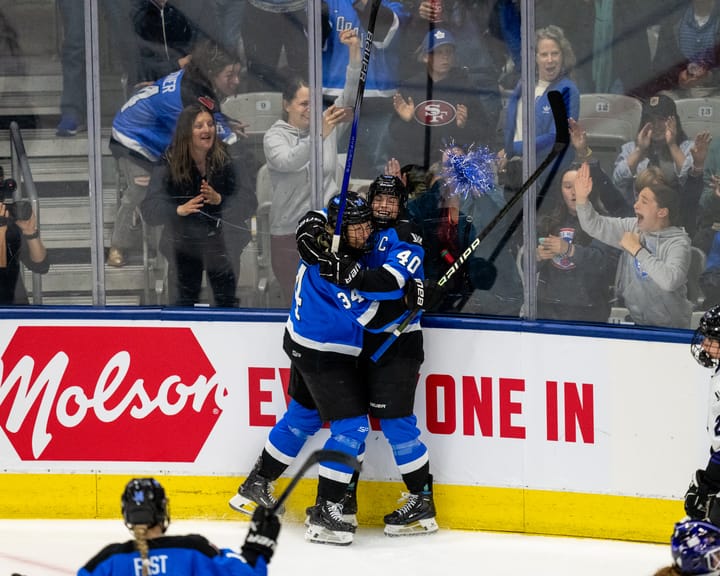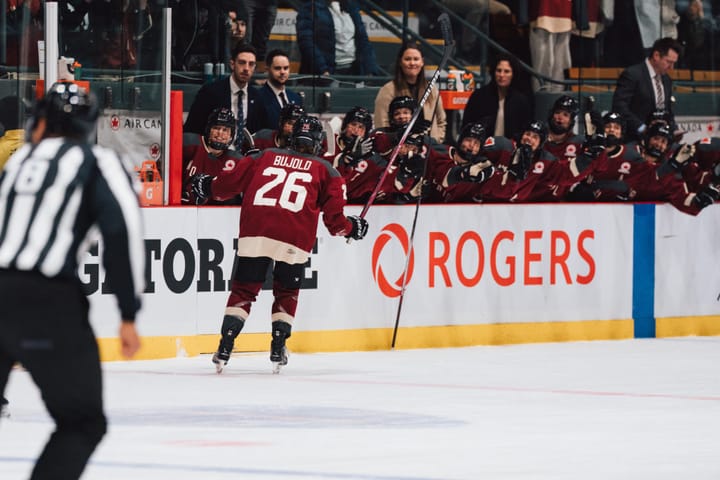Retiring Lamoureux twins reflect on growth of game in US and abroad
Two of the greatest have seen the world of women’s hockey change during their careers
Monique Lamoureux-Morando and Jocelyne Lamoureux-Davidson played hockey for two NCAA D1 programs, represented their country in seven IIHF World Championships, and played in three Winter Olympic Games. They’ve played hockey across the globe, done it all, seen it all, and won it all, and are leaving the game on their terms — as champions.
It’s hard to put into words just how important the twins have been to Team USA’s identity for the past 15 years. We are all familiar with the adjectives that have been in constant orbit around the twins since they demanded national attention with their play at the universities of Minnesota and North Dakota. The Lamoureuxs are eternally fierce, loyal, relentless, driven, talented, pugnacious, fiery, and clutch.
It’s fitting that there are two Lamoureuxs because for so many years they were Team USA’s engine. They were the lungs driving forward an apex predator eager to prove its superiority against an eternal rival in Team Canada. Jocelyne, a perpetually underrated forward with peerless hands and vision; Monique, somehow equally brilliant as both a forward and a defender. Both beautiful skaters. Both with work ethics that would put a combustion engine to shame.
They’ve also both had front-row seats watching the game develop at home and abroad since they made their national team debuts in their teens. The sport changed with them and around them over the past 15 years. They’ve watched Finland begin close the gap on Team USA and Canada and watched the next generation of talent rise to elevate the game as they went from kids to leaders to icons wearing red, white, and blue. In their media availability on Feb. 8, they talked about how the game has changed and where it is going.
“We didn’t have an opportunity to play on girls’ teams growing up,” Jocelyne said during the twins’ retirement media conference. “In 2010, everyone but one player on our team had to play on boys’ teams growing up. Then, in 2018, you take that same poll and I’d say it was about half and half — so half the team played on girls’ teams all the way growing up. I would say that speaks to the opportunities that girls have today and the competitiveness.
“I would say on a grassroots level, it’s changing,” Jocelyne continued. “I think when you win an Olympic gold medal on that stage, and how important the Olympics is to the United States, that changes opportunity every four years. That’s always been important, obviously, winning medals ... I think that’s the next step, continuing to support the national teams through the U-18 and U-22 teams and continuing to grow women’s hockey from the top down to the bottom up.”
Monique observed that players on the US national team are playing longer and are getting better. This could speak to some of the post-collegiate options that exist for women to help them continue their games in the States, but it also is a sign of just how much the game has grown. The athletes keep getting better. The game keeps on growing.
Related
Monique Lamoureux-Morando, Jocelyne Lamoureux-Davidson retire from Team USA
And that growth is not exclusive to the United States. As one might suspect, that growth is hardly uniform and comes down to how much support national team programs are getting. This isn’t as simple as Finland is better at hockey than Sweden or Russia.
“I think it’s different for different countries, obviously Finland is up-and-coming — they almost won Worlds last year on a questionable call,” Jocelyne Lamoureux-Davidson told the Ice Garden. “That’s been exciting to see, and then there’s been dropoffs with other teams.”
One of the teams that has dropped off is Team Sweden. It may be hard for some to believe, but the Swedes have never won a medal in a Worlds or Olympics that the Lamoureuxs competed in. The SDHL is considered one of the top women’s leagues in the world, but the shortcomings of the national team have called into question the leadership and resources available to girls and women in Sweden on and off the ice. Those concerns were amplified and brought to center stage when the national team went on strike and unionized in 2018.
“I think the bigger question at play is how are governing bodies supporting their national women’s teams — and not just in an Olympic year,” Jocelyne added. “Russia has gotten a lot better since we played them in our first Worlds in 2009. Overall, the competition has gotten a lot better, but I also think there’s going to be a generation of players who have played in the U-18 championships (where) we’ll start to see the progress of creating more grassroots programs in different countries to support women playing throughout their lives.”
Related
The prevalence and growth of women’s hockey across the globe
The twins have seen that growth firsthand but know that it will take time before we see a huge shift in parity in international women’s hockey, “[It] takes a generation,” Jocelyne Lamoureux-Davidson explained. “It doesn’t happen overnight. It doesn’t happen with strict two-year training programs leading up to Olympic Games. It happens at the grassroots level.”
The Lamoureuxs were quick to mention Northeastern’s Alina Müller, now 22, as an example of a rising European star. The good news is that Müller is one of many exciting young stars from outside of North America who can shape the future landscape of the sport. One can only hope that governing bodies across the world will look at examples like Müller and recognize the value in investing in girls and women’s hockey. Far too often we see interest from those bodies wax and wane with the Olympic schedule, especially when their nations are hosting.
At least one thing is certain, the game has grown immensely in the US and across the globe since the arrival and departure of the Lamoureux twins and recently retired Team USA captain Meghan Duggan. These are exciting, transformative years for the women’s game. It’s also worth noting that Jocelyne Lamoureux-Davidson is on the PWHPA’s board, so she may be off the ice — but that doesn’t mean her eyes have left the rink. Something tells me the same is true for her sister. They also have a book coming out in two months.
The twins are not yet done giving back to the game they helped change. Not by a long shot.
Related
Reflecting on two of women’s hockey’s best: A final farewell to Jocelyne and Monique Lamoureux





Comments ()